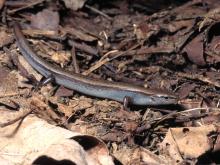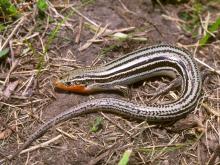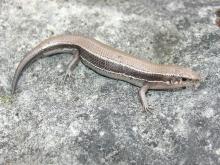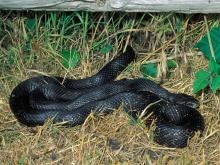Reptiles and Amphibians
Media

Species Types
Scientific Name
Scincella lateralis
Description
The little brown skink is a ground-dweller with dark brown or black stripes and speckling along the sides. Hiking in the woods, you may hear these small lizards scurrying through dead leaves, but you seldom see them. Occurs nearly statewide.
Media

Species Types
Scientific Name
Plestiodon septentrionalis
Description
Missouri has two subspecies of prairie skinks. They both have many stripes and a long tail. In Missouri, these lizards are rare. Northern prairie skinks occur only in our northwest counties. Southern prairie skinks are known only from Barton County, near Kansas.
Media

Species Types
Scientific Name
Plestiodon anthracinus pluvialis
Description
The southern coal skink is secretive. It lives in the southern half of Missouri, excluding the Bootheel. Adults are small, shiny, and brownish, with a wide, coal-black line on the side. Juveniles are black with faint lines down the back and sides and a blue-gray tail.
Media

Species Types
Scientific Name
Pantherophis obsoletus
Description
The western ratsnake, a glossy black snake, is one of Missouri’s largest and most familiar snakes. Its size and dark color make it seem imposing, but it is as harmless to humans as it is bad news for rodents.
See Also
About Reptiles and Amphibians in Missouri
Missouri’s herptiles comprise 43 amphibians and 75 reptiles. Amphibians, including salamanders, toads, and frogs, are vertebrate animals that spend at least part of their life cycle in water. They usually have moist skin, lack scales or claws, and are ectothermal (cold-blooded), so they do not produce their own body heat the way birds and mammals do. Reptiles, including turtles, lizards, and snakes, are also vertebrates, and most are ectothermal, but unlike amphibians, reptiles have dry skin with scales, the ones with legs have claws, and they do not have to live part of their lives in water.





















